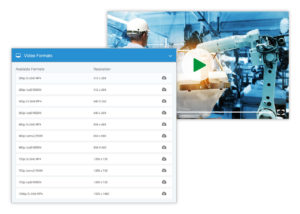What is a video CMS?
A video content management system (video CMS) is a CMS designed for video content management. While a standard content management system allows users to centrally manage, deliver, and share its text-based content, a video CMS allows them to do the same with their video content. Note that a standard CMS offers limited video capabilities and, therefore, cannot replace a dedicated video CMS.
Why use a video CMS?
As organizations scale their use of video, a centralized video solution is becoming ever more essential. Although standard CMS software usually support video to a certain extent, they are limited in terms of file size, features, integrations, and overall functionality, whereas a video CMS is a video-dedicated solution that offers:
Large Files Storage
Video files are typically heavy, as much as 1000 times heavier than a standard picture file. A one-minute video shot on a mobile device, for example, weighs 80MB, whereas a typical .jpg file size weighs 11.8 KB. Given their size, video files can easily exceed the default maximum size in many popular content management systems, including SharePoint (50MB) and WordPress (2MB-150MB).
Video CMS, on the other hand, can fully-support and host large files, allowing users to store and access as many videos as they’d like.
Buffer-Free Streaming
A standard CMS cannot guarantee seamless video delivery and device-compatibility. Video CMS, on the other hand, makes use of a process called transcoding to optimize video delivery across devices and network conditions.
When a user uploads a video to the video CMS, the system converts it into multiple video formats that are compatible with different devices. A video CMS can also adjust the video quality, depending on users’ internet/intranet connection speed.
Better Security
Hosting your sensitive videos on YouTube and other free video platforms comes with a price: security and privacy settings that are far from the stringent enterprise-standard. Data breaches have become much more common and much more malicious than in the past. According to Forbes, more than 4 billion records were exposed by data breaches within the first half of 2019, resulting in substantial losses, monetary and otherwise. In contrast, Video CMS comes with a host of authentication and authorization features, ensuring the right people access your videos at the right time.
Video Analytics
One of the most powerful tools in every business’s toolkit is analytics. Today’s businesses have access to a wealth of business intelligence tools. They are, therefore, capable of accurately assessing every aspect of their operations, including video. Video CMS usually offers a comprehensive video analytics tool that allows admins to extract insights related to their video assets, including top media, devices, drop-off, top countries/cities, etc.
Enhanced Video Search
Though a standard CMS does offer basic search capabilities, those are usually limited to manually-entered tags, title, and description. In many cases, like long training sessions or internal deliberations, this data simply isn’t comprehensive enough.Some video CMSs allow users to search for content inside the video itself. Some, like movingimage’s VideoManager Pro, take enhanced search a step further using artificial intelligence. AI further extends indexing capabilities by employing computer vision and automated transcription, allowing the auto-generation of metadata and subtitles.
Video integrations
Video integrations are the missing link between companies’ existing infrastructure and the new video management system.Widget-based plugins combined with REST API allow companies to seamlessly integrate videos into their existing technology landscape.
Video CMS use cases
A video content management platform can be used for multiple video purposes, including:
Video Management and Sharing
As its name suggests, video CMS’s main functionality is the management of video assets, including sorting, sharing, and editing.
Livestreaming
Besides on-demand video streaming, a video content management software should fully support live streaming—a corporate use case that is gaining traction due to digital transformation.
Social Intranet
Video CMS allows companies to create and maintain a video portal that combines the best features of social media platforms, internal collaboration sites, and company video portals.
Support and Maintenance
Video is a powerful tool for customer support and troubleshooting. Using a video CMS, companies can incorporate detail-rich video into their support and maintenance workflows.
Corporate Learning
Video is the perfect medium to accommodate corporate learning: It’s more engaging, informative, and memorable than any other medium. And indeed, many companies use video CMS to incorporate video into their training and learning activities.
What’s the difference between a video CMS and an enterprise video CMS?
An enterprise video CMS is distinguished from standard video content management systems in that it emphasizes the processes and procedures of the enterprise, mainly compliance, corporate governance, and business continuity.
In contrast, a video CMS typically gives little thought to enterprise requirements. For example, national data protection regulations and security standards.
How to choose the best Enterprise Video CMS? (or: what to look for in a video CMS)
A capable video content management software must be an all-in-one, holistic solution. It should be able to:
- Accommodate customers with varying needs, from compliance to video use cases
- Easily integrate into companies‘ IT landscape, including a robust API
- Offer reliable CDN and eCDN video delivery
- Offer enterprise-level security features
- Offer 24/7 customer support












